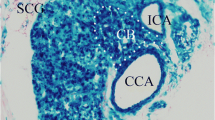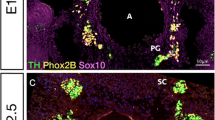Abstract
Cells constituting the sympathoadrenal (SA) cell lineage originate from the neural crest and acquire a catecholaminergic fate following migration to the dorsal aorta. Subsequently, SA cells migrate to sites widely dispersed throughout the body. In addition to endocrine chromaffin and ”small intensely fluorescent” cells in adrenal glands and in extra-adrenal tissues such as the paraganglia, this lineage also includes neurones located in sympathetic ganglia and in the adrenal gland. It is widely assumed that these cells are all derived from the same precursors, which then differentiate along divergent pathways in response to different external stimuli. During embryonic differentiation, SA cells lose some of their early traits and acquire other distinguishing features. To help understand how the lineage diverges in terms of phenotype and function, this article examines the cellular expression of a variety of ”marker” proteins that characterize the individuals of the lineage. In particular, differences between adrenal medullary adrenergic and noradrenergic chromaffin cells in the expression of proteins, such as the neural adhesion molecule L1, the growth-associated protein GAP-43 and molecules involved in the secretory process, are emphasized. Factors that might differentially regulate such molecular markers in these cells are discussed.
Similar content being viewed by others
Author information
Authors and Affiliations
Additional information
Received: 29 December 1998 / Accepted: 1 April 1999
Rights and permissions
About this article
Cite this article
Langley, K., Grant, N. Molecular markers of sympathoadrenal cells. Cell Tissue Res 298, 185–206 (1999). https://doi.org/10.1007/PL00008810
Issue Date:
DOI: https://doi.org/10.1007/PL00008810




